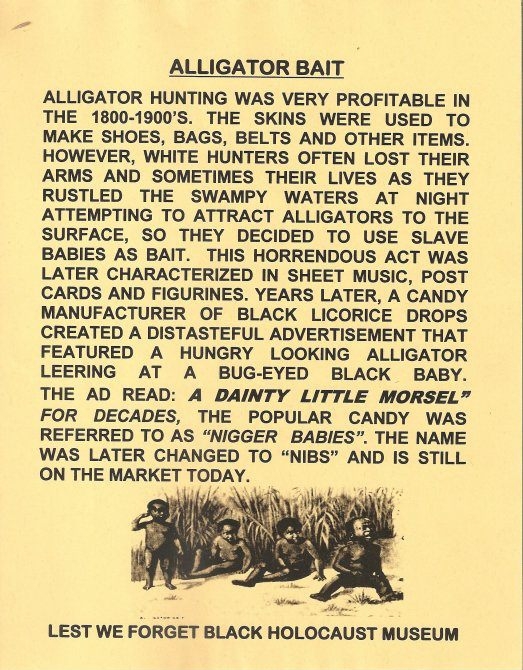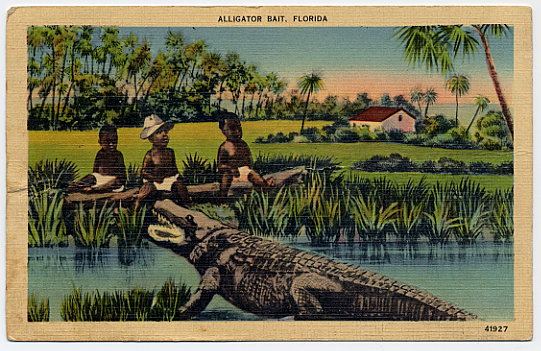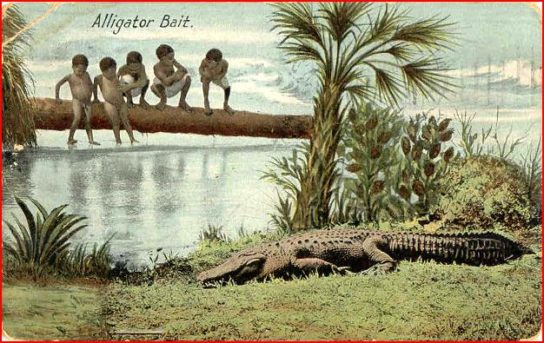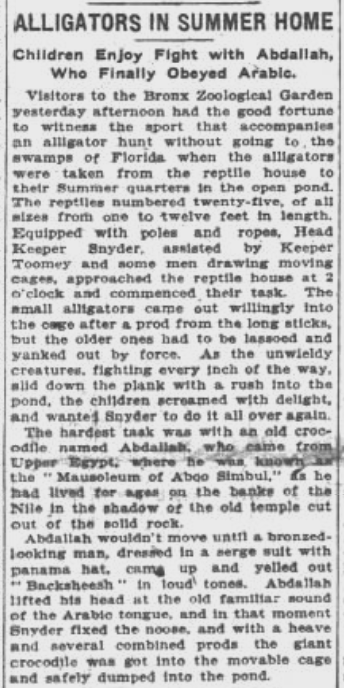The Internet is a wonderful tool for learning, but sometimes the most important lesson it teaches us is that we can't take the information we find there for granted.
A tidbit of historical trivia making the social media rounds since the late 2000s purports to reveal a shocking and little-known example of racist cruelty in the United States' past, namely that profit-seeking white hunters in the deep South of the 19th and early 20th centuries used black "slave babies" to lure alligators out of the swamps to be killed so that their skins could be harvested:
Among other places, these claims are elaborated on in an April 2012 forum post asserting that black infants were not only routinely served up as alligator bait, but horribly "skinned alive" in preparation for it:
"Alligator Bait" is the term drives [sic] from an activity conducted by white men, mostly in the swamps of Louisiana and Florida throughout the south. These white people were sick beyond belief. These alligator hunters needed to lure the larger bull alligators with human flesh and blood. During the slave era, our ancestors in America were only considered 3/5 of a human being. Which is why these sick hunters had no regard for human life! The alligator hunters kidnapped black infants, skinned them alive, and tied their neck to a string and dropped them into a swamp! Dangling them near the mouths of hungry 700 pound alligators! These black babies were stolen, caged and fed to alligators whole! The activity is retold in various forms in researched documents, many found in the Jim Crow Museum of Racist Memorabilia in Michigan.
A 2014 article in the Miami New Times agreed that these claims are supported by good research:
It has been pretty well documented recently that, during slavery and into the 20th Century, black babies were used as alligator bait in North and Central Florida.
One of the most frequently cited sources for said documentation is the Jim Crow Museum at Ferris State University in Big Rapids, Michigan, which does, in fact, house artifacts (e.g., postcards, knickknacks, and product packaging, and the like) demonstrating how pervasive derogatory imagery of black people was in American popular culture right up through the mid-20th century.
'Mammy's Little Alligator Bait'
Shelved in the museum alongside the many stereotypical representations of "pickaninnies" (a racial slur applied to African-American youngsters) speaking fractured English, eating watermelon, catching opossums, etc., are similar cartoonish portrayals of black children (and sometimes black adults) as worthless "alligator bait." In a chapter by that name in her 2002 book Ceramic Uncles and Celluloid Mammies: Black Images and Their Influence on Culture, UCLA folklorist and African American studies professor Patricia Turner wrote that such artifacts "depict more than just the presence of a negative stereotype; they implicitly represent a form of aggression in eradicating an unwanted people."
Most of these ugly images (evidently regarded as humorous in their day) are variations of the scenes depicted in the vintage postcards below (courtesy of Wikimedia Commons):
Likewise, the representation of black children as "alligator bait" was perpetuated in motion pictures and popular song — for example, the not-so-sweet lullaby "Mammy's Little Alligator Bait," composed by Henry Wise and Sidney Perrin in 1899:
[Chorus]
Hush-aby, don't yo' cry,
mammy's little piccaninny's gwine to get a present mighty soon,
When de stars am a-peepin' and de moon it am a-creepin'
den yo' mammy's gwine to sing 'dis tune,
Shut yo' eye bye and bye,
mam will whip yo' if yo' cry,
Someone am a-comin' thro' de gate;
Go to sleep, don't yo' peep,
listen to me tell yo',
yo's mammy little alligator bait.
Despite confirming the widespread dissemination of such grotesque representations of African Americans in the 19th and 20th centuries, however, the existence of these artifacts does not suffice to prove that black children were literally used as alligator bait in the South. Neither do press reports dating back to the time period when the practice was supposedly commonplace.
'Zoo Specimens Coaxed to Summer Quarters by Plump Little Africans'
An article on the Jim Crow Museum's web site arguing that real-life "alligator bait" incidents, however rarely they may have occurred, have been "documented" relies mainly on contemporaneous news reporting as evidence:
African American babies being used as alligator bait really happened, and it happened to real people. It doesn't seem to have been a widespread practice, but it did happen.
It is hard to process the thinking that could lead a person to actually use a live human baby as bait for an alligator. That is why the objects in the Jim Crow Museum are so important — they help tell the story of a society that defined African Americans as "sub-human" by portraying them as savage and worthless creatures ("Americans Forced", 1944). If people are indoctrinated, over and over again, with items, images, objects, and practices that devalue the humanity of African Americans, then practices like "African Dodger", "Human Zoos" and "Alligator bait" become possible.
In 1908 the Washington Times reported that a keeper at the New York Zoological Garden baited "Alligators With Pickaninnies" out of their winter quarters. In the article two "small colored children happened to drift through the reptile house among the throng of visitors" and they were "pressed into service." The alligators "wobbled out as quick as they could after the ebony mites, who darted around the tank just as the pursuing monsters fell with grunts of chagrin into the water." The alligators were "coaxed" into their summer quarters by "plump little Africans" ("Baits Alligators").
The passage accurately quotes a story that appeared in the Washington Times (and many other papers across the country) on 13 June 1908:
One ought not to take its veracity for granted, however, not least because it is studded with such "facts" as the following:
It was a keeper's idea to bait the saurians with pickaninnies, knowing as he did their epicurean fondness for the black man.
In our attempt to verify the report, we found no such reference to the use of "pickaninnies" to bait alligators in the place where one would most expect it to turn up, the New York Times.
But we did find an item in the Times, one that was published on the same date (13 June 1908), describing the transfer of the same number of alligators (25) from their winter to their summer housing in New York's Bronx Zoological Garden. There is no mention whatsoever of "bait":
Visitors to the Bronx Zoological Garden yesterday afternoon had the good fortune to witness the sport that accompanies an alligator hunt without going to the swamps of Florida when the alligators were taken from the reptile house to their Summer quarters in the open pond. The reptiles numbered twenty-five, of all sizes from one to twelve feet in length. Equipped with poles and ropes, Head Keeper Snyder, assisted by Keeper Toomey and some men drawing moving cages, approached the reptile house at 2 o'clock and commenced their task. The small alligators came out willingly into the cage after a prod from the long sticks, but the older ones had to be lassoed and yanked out by force. As the unwieldy creatures, fighting every inch of the way, slid down the plank with a rush into the pond, the children screamed with delight, and wanted Snyder to do it all over again....
It's the same incident, clearly. And, just as clearly, the pickaninnies-as-bait trope must have been fabricated by out-of-town editors with no qualms about exploiting racist stereotypes to sell the story.
'Pickaninny Bait Lures Voracious 'Gator to Death'
Another oft-cited article details an incident that supposedly happened in a place called Chipley, Florida in 1923. This is from the Jim Crow Museum:
The headline in the September 21, 1923 Oakland Tribune reads "PICKANINNY BAIT LURES VORACIOUS 'GATOR TO DEATH. And Mother Gets Her Baby Back in Perfect Condition; Also $2". In the article T.W. Villiers chronicles the entire process of using black babies as bait and how "these little black morsels are more than glad to be led to the 'sacrifice' and do their part in lurking the big Florida gators to their fate without suffering so much as a scratch." Villiers is quick to point out that the babies are brought out of the "water alive and whole and come out wet and laughing" and that "there is nothing terrible about it, except that it is spelling death for the alligators." In a strange twist, Villiers reports on the hunter's attempts to rationalize the motivation of the alligators to
"jeopardize every hope of life for a live baby, and in the matter of color, the additional information is vouchsafed that black babies, in the estimation of the alligators, are far more refreshing, as it were, than white ones."
The article describes the process of placing the babies near the alligator's haunts, with the hunters hidden behind the brush with their rifles. When the baby "attracts" the gator and it exposes his "head and forequarters", the hunters shoot the gator and claim their "prize." And, just in case someone happens to care about the welfare of the baby, the reader is assured that "Florida alligator hunters do not ever miss their targets." After the baby is returned to its mother, she is paid the set price of two dollars (Villiers, 1923).
Again, we find that the article has been accurately quoted, but we're skeptical of the reliability of the information it purveys, including such nuggets of wisdom as the following:
Above all other things, the alligator is most fond of human flesh as an item of diet. Hunters say that while an alligator will risk its safety for a young dog, it will jeopardize every hope of life for a live baby. And in the matter of color, the additional information is vouchsafed that black babies, in the estimation of the alligators, are far more refreshing, as it were, than white ones.
Needless to say, the journalistic standards of 1923 weren't quite up to what we're used to today. We submit, in fact, that despite its syndication in newspapers all over the country this tall tale is not an example of journalism at all. On the contrary, it was an occasion for the author to indulge in racist stereotyping of the most degrading — yet salable — kind.
Even Time magazine was suckered into synopsizing the tale. They ended up running this disavowal a few weeks later:
On behalf of the town of Chipley, Fla., the Orange County Chamber of Commerce branded as "a silly lie, false and absurd," the story (broadcasted a month ago through the press of the nation) that colored babies were being used at Chipley for alligator bait. In its issue for Oct. 15, TIME printed the fact that the report had been circulated, but in no wise vouched for its authenticity. TIMES story was as follows: From Chipley, Fla., it was reported that colored babies were being used for alligator bait. "The infants are allowed to play in shallow water while expert riflemen watch from concealment nearby. When a saurian approaches his prey, he is shot by the riflemen."
The Louisville Herald: "Florida alligator hunters do not ever miss their target"
The price reported as being paid colored mothers for the services of their babies as bait was "$2.00 a hunt."
Neither of the two "news" stories thus far put forward as "evidence" of black children being used as alligator bait — the first published in 1908, the second in 1923 — is credible. One proved to be a fictionalization of a New York Times report that never once mentioned "pickaninnies," while the other is best characterized as racist satire. (So far as we were able to determine, the byline of its credited author, "T.W. Villiers," never appeared on another published article, before or since, anywhere.)
'A Peculiarity of Crocodile Hunting in East India'
Equally incredible are articles we came across during our research reporting that infants have been similarly used as "crocodile bait" in countries other than the United States. For example, a story in the 10 August 1894 edition of the Mansfield Daily Shield purported to chronicle the exploits of a British officer hunting crocodiles in India:
"We used to have great sport in India going out after crocodiles with Hindoo babies for bait," said an ex-army officer of the British army. "The baby wasn't baited on a hook like a minnow or a fish worm, but simply secured on the river bank so that it couldn't creep or toddle away or tumble into the river. Some babies don't like their being made crocodile bait of, but that fact increased their value to the sportsmen, for then they yelled and made a great noise, which was just what the crocodiles were waiting to hear, and they'd come hurrying from all directions to have a chance at the babies.
"Where did we get these babies for bait? From their mothers. All the fellow who wanted to go crocodiling had to do was to noise abroad his intention and it wasn't long before native women would flock in with their babies to be rented out for bait. The ruling price per head for the young heathen was about six cents for the day...."
The entire article, which goes on at some length, is based on the testimony of a single individual: an unnamed ex-British army officer who claimed not only that he bagged 100 crocodiles by using the same "Hindoo infant" as bait again and again, but also that when he tried to accomplish a similar feat in Florida, he was rebuffed by the local mothers:
"I was in Florida a year or so ago and tried to hire a baby to experiment with for alligators after the method in India, but folks who owned babies down there didn't seem to enter into the spirit of the sport, and I couldn't get one. I compromised on a rather lively and complaining dog...."
A 31 October 1899 article in the Youngstown Vindicator purported to draw comparisons between how alligators were hunted in the American South and how crocodiles were hunted in Asia and Africa:
The alligator is like the crocodile in this respect. He likes to eat babies, not his own awkward offspring, but nice human babies, fat and dimpled. To obtain such a delicacy for his palate an alligator will travel far and risk much. This fact is so well known that it has become the practice for alligator or crocodile hunters to use babies as bait to lure the reptiles to their death.
A nice, fat baby is rented for the occasion from the cracker mother to whom a half dollar is ample recompense for the risk that her child is to run. The baby is then taken to the shore of some pond or river, where it is attached to a stake by means of a stout cord that has been tied around its waist, while the hunter conceals himself in the brushes or swamp grass near the place.
But note the similarities (including some identical phrasing) between that article and this one published in New Zealand's North Otago Times two years before (in April 1897):
Crocodiles like to eat babies, not their own awkward offspring, but human darlings, fat and dimpled. Skinny babies are not adapted to the crocodilian palate and are passed by, almost with scorn. But an alligator will crawl a very long distance for a fat one. This liking of the saurian for babies is utilized by hunters in Ceylon to lure the reptiles to their death.
A nice, fat baby is tied by the leg to a stake near some pond or lagoon where crocodiles abound. So, soon as the child begins crying the sound attracts those crocodiles within hearing distance. They start out immediately for the howling infant. The hunter in the meantime conceals himself in the bushes or swamp grass near the baby, with a rifle in his hand projecting out almost over the child.
We found many other instances of the adaptation of this story (which, despite appearances, almost certainly originated in the United States), some versions dating back to 1888. It was still making the rounds 10 years later.
Jews as crocodile bait?
Perhaps the oddest variant of the "bait" theme we came across was this story published in the Toronto Daily Mail on 28 May 1891, holding that Jewish babies stolen in Russia were being used as bait to hunt crocodiles in Egypt:
For a year or so hundreds of Jewish babies have been stolen and shipped to various ports on the Nile to be used as bait by the crocodile hunters. Of course, they are not all eaten by the animals, but now and then one is caught. The crocodile hunters place a baby on the shores of the stream, and presently the lazy animals come out of their beds after the infant. When the crocodiles get near the little one and within shooting range of the hunters, who are concealed in the bushes, they are shot. The little babes serve as a bait to bring the animals on the banks, and by this means it is possible to get many animals which could not be reached in any other way.
Apart from crocodilians and babies, the common threads running through all these reports are racism, xenophobia, and the utter lack of specifics. If we take them seriously, we have no choice but to conclude that using human infants as alligator bait was incredibly widespread at some point in time; yet, we have not encountered a single report that included enough detail to verify that even one such incident actually took place. They're just tales.
We are unable to prove the negative, of course. We cannot demonstrate that no infant anywhere, irrespective of color or creed, was ever used as reptile bait. But neither has anyone proved to date that infants were, in fact, used in such a manner.
We checked this conclusion with folklorist and African American studies professor Patricia Turner, who has probably done more research on the "alligator bait" motif than anyone else in the world, and asked her if she had ever come across information suggesting that the phenomenon might be real. "I have not seen any evidence to suggest that it was true," she said, adding that it would have been all the more unlikely during the era of slavery, when a black child would have been a much more valuable commodity than an alligator.
Regardless, it is true that the notion that dark-skinned children were the favorite food of alligators and crocodiles, like so many other demeaning stereotypes about people of African descent, was already commonplace in the antebellum United States ("...they prefer the flesh of a negro to any other delicacy," Fraser's Magazine reported as a scientific fact in 1850). It's therefore plausible to suppose that the epithet "alligator bait" did not follow from, but rather preceded the existence of stories depicting black children as such, which would relegate those stories to mere folklore.







